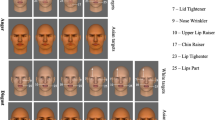Abstract
This experiment compares the explicit use of categorical and dimensional decoding strategies to recognize facially expressed emotion. Results suggest that people can consciously employ both strategies but that their facility in doing so is a function of the particular emotion displayed in combination with the completeness of the expression. By identifying the relative effectiveness of deliberate use of particular decoding strategies in specific circumstances, this investigation has implications for the design of facial decoding studies, for further research into cognitive mechanisms underlying the recognition of facially expressed emotion, and for development of practical applications to enhance facility with facial decoding.



Similar content being viewed by others
References
Adolphs, R. (2002). Recognizing emotion from facial expressions: Psychological and neurological mechanisms. Behavioral and Cognitive Neuroscience Reviews, 1, 21–62.
Bimler, D., & Kirkland, J. (2001). Categorical perception of facial expressions of emotion: Evidence from multidimensional scaling. Cognition and Emotion, 15, 633–658.
Calder, A. J., Burton, A. M., Miller, P., Young, A. W., & Akamatsu, S. (2001). A principal component analysis of facial expressions. Vision Research, 41, 1179–1208.
Calder, A. J., Young, A. W., Keane, J., & Dean, M. (2000). Configural information in facial expression perception. Journal of Experimental Psychology: Human Perception and Performance, 26, 527–551.
Calder, A. J., Young, A. W., Perrett, D. I., & Etcoff, N. L. (1996). Categorical perception of morphed facial expressions. Visual Cognition, 3, 81–117.
Ekman, P., Friesen, W. V., & Ellsworth, P. (1982a). What are the relative contributions of facial behavior and contextual information to the judgment of emotion? In:P. Ekman (Ed.), Emotion in the human face (pp. 111–127). New York: Cambridge University Press.
Ekman, P., Friesen, W. V., & Ellsworth, P. (1982b). What emotion categories or dimensions can observers judge from facial behavior? In: P. Ekman (Ed.), Emotion in the human face (pp. 39–55). New York: Cambridge University Press.
Ekman, P., Friesen, W. V., & Hager, J. C. (2002). The facial action coding system (Computer software). Retrieved from http://face-and-emotion.com/dataface/facs/new_version.jsp.
Ekman, P., & Matsumoto, D. (1993). Combined JACFEE and JACNEUF(Computer software). Retrieved from http://www.paulekman.com/research_cds.php.
Elfenbein, H. A., & Ambady, N. (2002). On the universality and cultural specificity of emotion recognition: A meta-analysis. Psychological Bulletin, 128, 203–235.
Etcoff, N. L., & Magee, J. J. (1992). Categorical perception of facial expressions. Cognition, 44, 227–240.
Huberty, C. J., & Morris, J. D. (1989). Multivariate analysis versus multiple univariate analyses. Psychological Bulletin, 105, 302–308.
Izard, C. E. (1971). The face of emotion. New York: Appleton-Century-Crofts.
Katsikitis, M. (1997). The classification of facial expressions of emotion: A multidimensional-scaling approach. Perception, 26, 613–626.
Lang, P. J., Bradley, M. M., & Cuthbert, B. N. (1999). International affective picture system (IAPS): Instruction manual and affective ratings. Technical Report A-4. The Center for Research in Psychophysiology: University of Florida.
Russell, J. A. (1994). Is there universal recognition of emotion from facial expressions? A review of the cross-cultural studies. Psychological Bulletin, 115, 102–141.
Russell, J. A. (1997). Reading emotion from and into faces: Resurrecting a dimensional-contextual perspective. In: J. A. Russell, & J. M. Fernández-Dols (Eds.), The psychology of facial expression (pp. 275–294). Cambridge, UK: Cambridge University Press.
Russell, J. A., Weiss, A., & Mendelsohn, G. A. (1989). Affect grid: A single-item scale of pleasure and arousal. Journal of Personality and Social Psychology, 57, 493–502.
Schlosberg, H. (1952). The description of facial expressions in terms of two dimensions. Journal of Experimental Psychology, 44, 229–237.
Takehara, T., & Suzuki, N. (2001). Robustness of the two dimensional structure of recognition of facial expression: Evidence under different intensities of emotionality. Perceptual and Motor Skills, 93, 739–753.
Tomkins, S. S. (1984). Affect theory. In: K. R. Scherer, & P. Ekman (Eds), Approaches to emotion (pp. 163–195). Mahwah, NJ: Erlbaum.
Wagner, H. L. (1993). On measuring performance in category judgment studies on nonverbal behavior. Journal of Nonverbal Behavior, 17, 3–28.
Wallbott, H. G., & Ricci-Bitti, P. (1993). Decoders’ processing of emotional facial expression—a top-down or bottom-up mechanism? European Journal of Social Psychology, 23, 427–443.
Young, A. W., Rowland, D., Calder, A. J., Etcoff, N. L., Seth, A., & Perrett, D. I. (1997). Facial expression megamix: Tests of dimensional and category accounts of emotion recognition. Cognition, 63, 271–313.
Acknowledgments
The research reported here was supported in part by National Institutes of Health Grant MH58800. I thank Elaine Bond for helpful comments and critical reading of drafts of this article and Mark C. Clayton and Michael B. Kitchens for their assistance with data collection.
Author information
Authors and Affiliations
Corresponding author
Rights and permissions
About this article
Cite this article
Mendolia, M. Explicit Use of Categorical and Dimensional Strategies to Decode Facial Expressions of Emotion. J Nonverbal Behav 31, 57–75 (2007). https://doi.org/10.1007/s10919-006-0020-4
Published:
Issue Date:
DOI: https://doi.org/10.1007/s10919-006-0020-4




